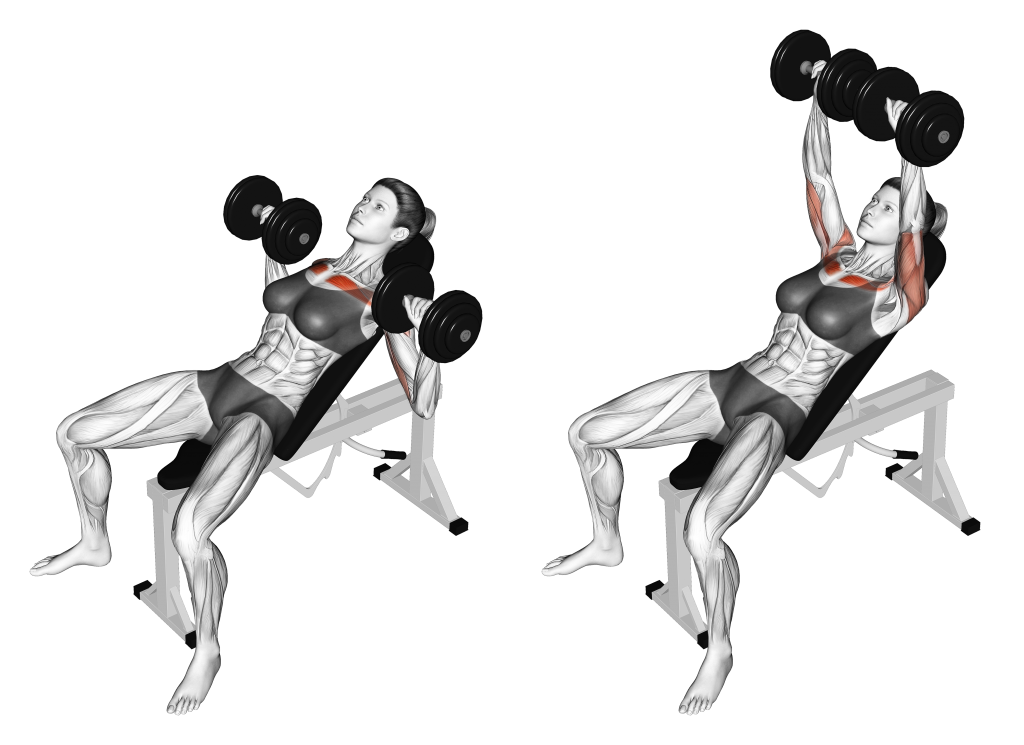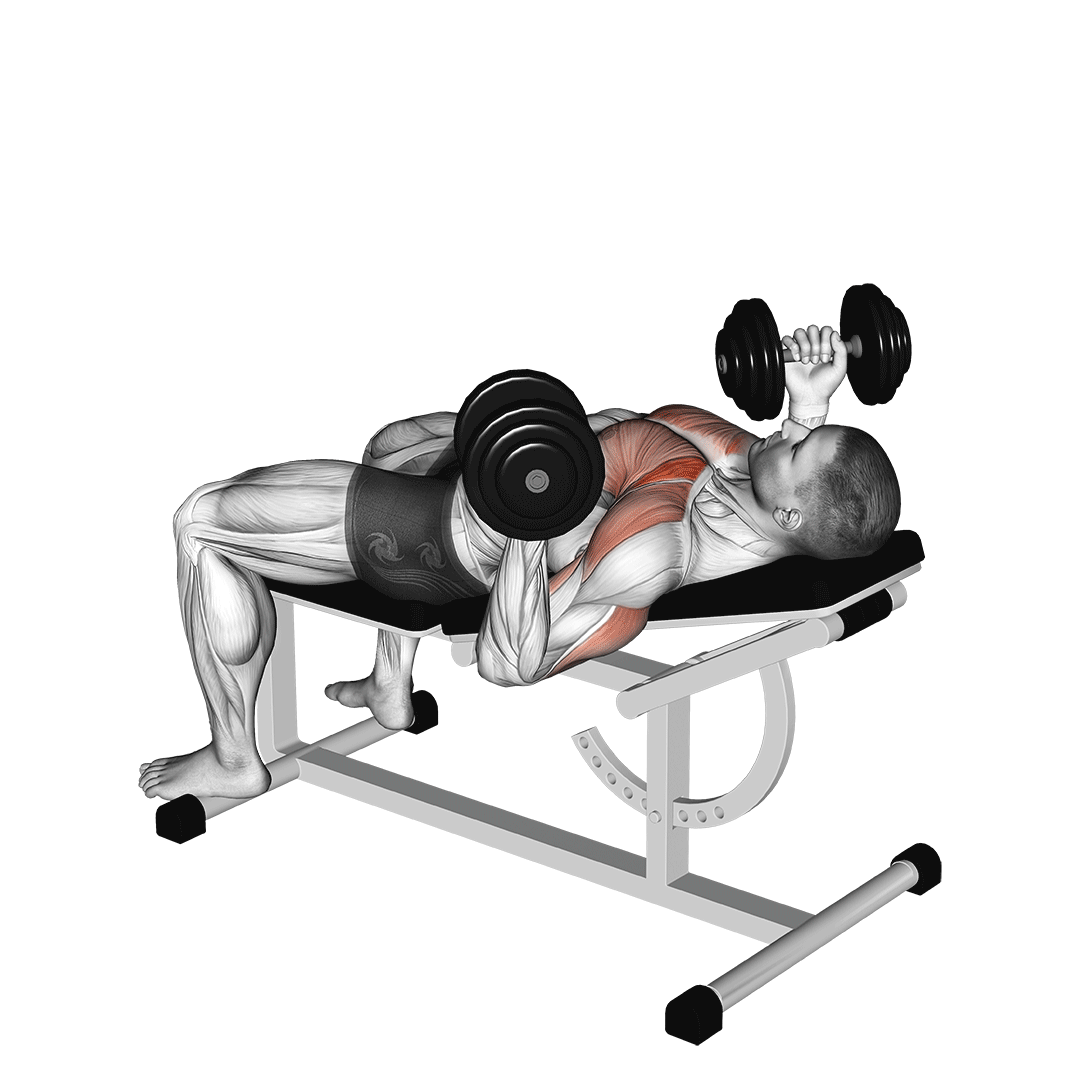7 Best Dumbbell Bench Press Variations (With Pictures)
1. The Incline Dumbbell Bench Press
First and the most common among the dumbbell bench press variants, the incline dumbbell press differs from the dumbbell bench press by the manner of the exerciser placing themselves on a bench adjusted at an upward angle, thereby forcing more of the upper chest (pectoralis major) to activate.

This also has the benefit of placing more mechanical tension of the anterior deltoids, both as stabilizing muscles and as secondary mover muscles and therefore imparting better muscular hypertrophy and strength gains in the front of the shoulder muscles.
The incline dumbbell bench press may even be used in combination with the traditional dumbbell bench press so as to fully activate the pectoralis muscle group in a more efficient manner, though this purpose can just as readily be done with any other pectoralis focused exercise.
2. The Decline Dumbbell Bench Press
The opposite in terms of angle to the incline dumbbell bench press, the decline dumbbell bench press instead places the exerciser at a downward angle so as to maximize the activation of the pectoralis minor and latissimus dorsi, both of which are utilized for pushing the dumbbells away from the torso – a task made more difficult by the direction of the exerciser’s body.

This, by extension, reduces the mechanical stress placed on the deltoids and triceps brachii, making the decline dumbbell bench press suitable for workout routines that already place significant training stimuli and fatigue on the aforementioned muscle groups.
As such, the decline dumbbell bench press is more suitable for exercisers and bodybuilders wishing to emphasize the lower portion of their chest muscles, as well as athletes looking for a more well-rounded upper body exercise push routine when also including such exercises like the military press and triceps isolation exercises as well.
3. Neutral Grip Dumbbell Bench Press
A bench press grip variation that is otherwise impossible without the use of dumbbells or other specialized equipment, the neutral grip dumbbell bench press is primarily performed with the exerciser holding the dumbbells in such a way that their palms face on another over their chest, hence the term neutral as this keeps the wrists in their most natural stance.
As such, the neutral grip dumbbell bench press both reduces the incidence of wrist injury as well as improves pectoral muscle group activation by placing a larger amount of strain on said chest muscles due to the nature of how they are activated.
If utilizing proper form, the neutral grip dumbbell bench press can also replicate the close grip barbell bench press in the manner of significantly activating the triceps brachii muscles as the dumbbells are held closer together than what would normally be done.
4. Single Hand Dumbbell Bench Press
Simply the bilateral form of a dumbbell bench press, the single hand dumbbell bench press is primarily performed for the purposes of improving the exerciser’s focus on a single side of their body – thereby allowing them to exert somewhat more energy and effort on a single side at a time, which may translate to improved benefits and results when combined with other anabolic factors.
The single hand dumbbell bench press can unbalance the exerciser during the eccentric portion of the exercise, requiring that they either find a suitably wide enough surface to lie upon or a stable enough object to grip as they complete the set.
A primary drawback to the single hand dumbbell bench press is that it takes approximately twice the length of time a unilateral dumbbell bench press exercise would take, a trade off that is left up to the individual to decide on whether it is worth the improved focus or not.
5. Spoto or Pause Dumbbell Bench Press
Primarily performed by high level athletes or individuals wishing to greatly improve the strength and function of their pectoral muscle group and triceps brachii, the pause dumbbell bench press makes use of not only dynamic contraction but also isometric type muscular contraction in order to maximize the benefits of performing the exercise.
This is done by the exerciser quite literally “pausing” a short distance away from their chest as they squeeze all the muscle groups involved in the movement, prior to resuming the repetition and only repeating this pause once they have begun another repetition.
6. Dumbbell Floor Press
Usually performed either by individuals with an injury that causes a reduction in their arm’s range of motion or by exercisers without access to a suitable enough bench, the dumbbell floor press is a variation of the dumbbell bench press with a significantly reduced range of motion that causes an increased level of resistance to be placed on the triceps as they bear the brunt of the load.

This can be quite beneficial for powerlifters wishing to train the lock-out portion of their bench press form, or exercisers desiring to place further emphasis on their triceps brachii muscle group without performing a close grip bench press exercise.
7. Reverse or Supinated Grip Dumbbell Bench Press
Performed with the palms of the exerciser facing inwards so as to increase the horizontal distance that the dumbbells must travel as well as place a certain level of emphasis on the biceps brachii muscle groups, a muscular activation that is not normally found in most dumbbell bench press variations.

The reverse grip dumbbell bench press is occasionally even considered an entirely different exercise to the dumbbell bench press itself, despite their similarities, and as such may require that the workout program of the exerciser performing it to be modified so as to account for the change in training stimuli and muscular activation.
This is especially applicable for high level athletes or powerlifters that are wishing to train their bench press strength or similar physical capacities, as the difference in muscular activation pattern, form and connective tissue strain can result in a training effect somewhat different from what the athlete may be expecting.
References
1. Saeterbakken AH, Mo DA, Scott S, Andersen V. The Effects of Bench Press Variations in Competitive Athletes on Muscle Activity and Performance. J Hum Kinet. 2017 Jun 22;57:61-71. doi: 10.1515/hukin-2017-0047. PMID: 28713459; PMCID: PMC5504579.
2. Saeterbakken AH, Stien N, Pedersen H, Solstad TEJ, Cumming KT, Andersen V. The Effect of Grip Width on Muscle Strength and Electromyographic Activity in Bench Press among Novice- and Resistance-Trained Men. Int J Environ Res Public Health. 2021 Jun 14;18(12):6444. doi: 10.3390/ijerph18126444. PMID: 34198674; PMCID: PMC8296276.
3. Lauver JD, Cayot TE, Scheuermann BW. Influence of bench angle on upper extremity muscular activation during bench press exercise. Eur J Sport Sci. 2016;16(3):309-16. doi: 10.1080/17461391.2015.1022605. Epub 2015 Mar 23. PMID: 25799093.
